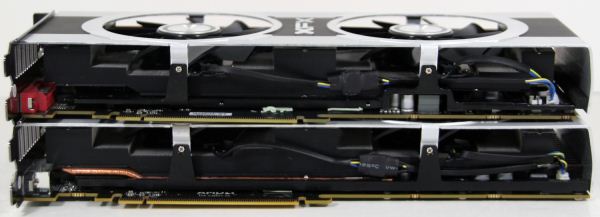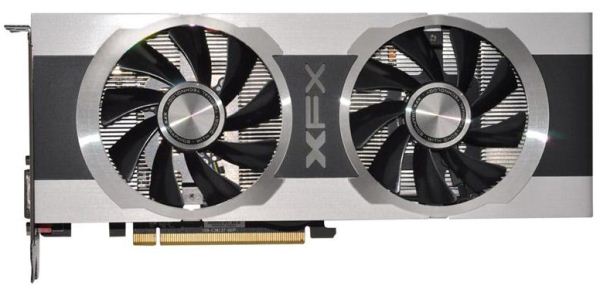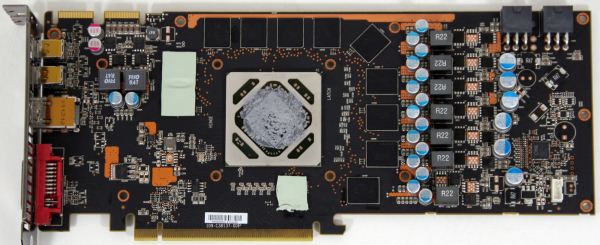AMD Radeon HD 7950 Review Feat. Sapphire & XFX: Sewing Up The High-End Market
by Ryan Smith on January 31, 2012 9:02 AM ESTMeet the XFX R7950 Black Edition Double Dissipation
Our second partner card of the day is XFX’s R7950 Black Edition Double Dissipation. Like the 7970 Black Edition Double Dissipation we reviewed earlier this month, the 7950 BEDD is a factory overclocked card (Black Edition) using XFX’s Double Dissipation cooler.
Starting with the overclock, XFX is shipping the 7950 BEDD with a core clock of 900MHz and a memory clock of 5.5GHz. This represents a 100MHz (12.5%) core clock overclock and 500MHz (10%) memory clock overclock, putting it just shy of the 925MHz core clock the 7970 ships at.
In terms of construction like all of the other 7950 cards launching today XFX is using AMD’s 7950 PCB. This means the PCB measures 10.25” long and features 2 6pin PCIe power sockets towards the rear of the card, while at the front the card uses the AMD standard port configuration of 1 DL-DVI, 1 HDMi, and 2 mini-DisplayPorts. The one notable deviation here from the Sapphire card is that XFX has not included a BIOS selection switch, so the card lacks any kind of ability to easily recover from a bad BIOS flash, and if unlocking proves viable it would not be a good candidate for the process.
Meanwhile cooling is provided by XFX’s Double Dissipation cooler. This is the same heatsink and fan assembly we saw with the 7970 BEDD, which makes this an open air cooler using a pair of fans to push air along an aluminum heatsink running almost the entire length of the card. Because it’s the same assembly, the shrouding for the card sticks out over the end of the PCB, negating the benefit of the shorter 7950 PCB and making the card 10.65” long just like the 7970 BEDD.

Top: 7950 BEDD. Bottom: 7970 BEDD
Do note that while it uses the same fan and heatsink assembly, Double Dissipation does not mean it uses the same vapor chamber assembly to transfer heat from the card. Where the 7970 BEDD used a fairly large vapor chamber, the 7950 BEDD uses a much smaller vapor chamber that only makes contact with roughly half of the heatsink, meaning that heat isn’t being transferred to the extremities of the heatsink nearly as well on the 7950 BEDD. Furthermore the aluminum plate covering the RAM and MOSFETs is poorly sized, leaving parts of the RAM chips (and their thermal pads) exposed. We’ll see how this plays out when we get to our testing, but the 7950 BEDD is clearly not as well built as the 7970 BEDD.
Rounding out the package is the same collection of extras that we saw in the 7970 BEDD. Inside you’ll find the usual driver CD and quick start guide, along with a metal XFX case badge, a mid-length CrossFire bridge, and a passive HDMI to SL-DVI adaptor. All of this is packed in one of XFX’s pleasantly small boxes, which doesn’t use much more space than the card itself.
The MSRP on the 7950 BEDD is $499, $50 over the MSRP for a regular 7950 and making it one of the more expensive 7950s launching today. XFX is offering a base 2 year warranty on the 7950 BEDD, which can be extended to a lifetime warranty by registering the card within 30 days of purchasing it.












259 Comments
View All Comments
chizow - Sunday, February 5, 2012 - link
You want to talk about respect while throwing out inflammatory comments like fanboy every reply while ignoring the actual facts and logic of an argument? Respect is given where its due.Anyways, like I said, just draw out the pricing history on these high-end parts for the last 5-6 years and you will see what AMD is doing here is unprecedented. At no point has one of these GPU makers ever asked for flagship prices with so little improvement over the last-gen flagships when using a new process node/GPU architecture.
If you are a reasonable person who is deserving of respect, I think you will find truth and reason in what I've written here, fanboyism and lack of respect aside.
Galidou - Sunday, February 5, 2012 - link
Find me anywhere I called you an idiot or a stupid or anything, the worse I said is that ultimate knowledge is crazyness, never called you crazy or ANYTHING, while you did it again., sad to see you have to resolve to those strategy as arguments....The lowest price I can find right now of the 7970 is 520$ and lowest I can find for 6950 is 240$, a little more than double as I said.
I said I trolled and I know it inflammatory comments and lack of respect is different, I was poking your ''facts'' and the way you react and still lack of respect toward me just shows even more...
''who is deserving of respect''
EVERYONE deserves respect and I will still respect you even if you don't for me because respect can't be bought, it is acquired or applied...
Galidou - Sunday, February 5, 2012 - link
And btw you still forgot to input the amount of memory which is 3gb that you forget everytime in your comments....Galidou - Sunday, February 5, 2012 - link
''If you are a reasonable person who is deserving of respect''I just still can't beleive you said that... ''who is deserving respect'' it's deceiving to see such lack of respect in a conversation about gpus,
I understand what you mean, Nvidia as always been about giving double the performance of last gen but they are hitting a wall where it won't be possible until they change the limit of the max TDP which is 300w, they are very close to it, I guess they left some space for double chip cards, but nvidia which isn't their strenght of watt/performance will probably have to change things if they want to squeeze double the gtx580 in their gtx680 in 300w TDP...
Considering ATI are the best at watts/performance and they only squeezed that kind of performance in 250w.....
chizow - Sunday, February 5, 2012 - link
6950 was as cheap as $180-$200 in some sales and the 7970 is $550-$600, so yes at times it was 3x.But the point remains, the 7970 does a worst job at upholding your standard than the GTX 280.
Also, it was a full 2x framebuffer, 8800GT was only 512MB, same as the 9800GX2 which was a massive amount of VRAM at the time. It was also more than the 512MB on the original 4870 with a full 512-bit bus.
Once again, the 280 was a flagship card by every metric, if you want to argue honestly over the facts, at least try to be honest about it.
Galidou - Sunday, February 5, 2012 - link
Yes you're right the 8800gt was 512mb, wasn'T there a 1gb version? I can'T remember...4870 was cheating, it used the first ddr5 memory so it doubled the bandwidth without adding die size, which helped ALOT to it'S great performance, I still like my 4870 which can almost still run everything very well...
Galidou - Sunday, February 5, 2012 - link
ok you want to go in the ''as cheap as'' well my friend got right after me a rebate with special and had a 8800gt for 150$ after everything, I was using regular price for my 8800gt at 180$, so consider a 8800gt at 150$ times 4.33 = 650$, wow, 4 times and a third....Galidou - Sunday, February 5, 2012 - link
IT WAS A FLAGSHIP CARD LOL the radeon 4870 got so close to it with a die half as big and that was what, a month and a half later... speak about flagship at 650$Galidou - Sunday, February 5, 2012 - link
worse than that, the radeon 4870 wasn't even meant to compete with the high end, AMD had left that market for single GPU but still it came SO CLOSE... speak about Flagshipn amzingness that doubles the previous generation.....Galidou - Sunday, February 5, 2012 - link
If you find something to say against my last comment I'm over with you, your closed mind will be the strognest I have ever seen. He will find a reason of the gtx 280 selling so high because of the Nvidia's CEO not having enough food on the table so they had to adjust the price....Poor them, send them food, they're starving!!